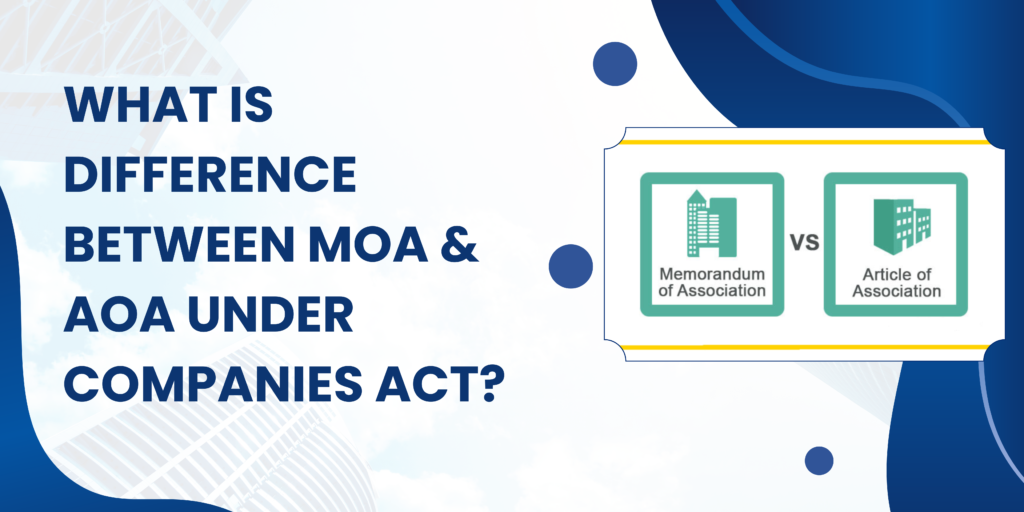
What is the Difference between MoA & AoA under Companies Act?
Memorandum of Association (MoA) and the Articles of Association (AoA) are two fundamental documents while Company Registration . These documents serve as the foundation of a company, governing its Business Objective, Capital, Rights & Duties of Its Shareholders & Directors. The MoA & AoA under Companies Act outline the company’s scope of activities and its governing rules & direction that how the activities of the company will carry in future.
The Understanding of difference between MOA & AOA is important to all Professionals & Stakeholders.
What is the Memorandum of Association (MoA)?
The Memorandum of Association (MoA) is a legal document that defines the company’s fundamental document of the company, laying down its objectives, scope of operations, and relationship with stakeholders. The MoA is a public document and which come into existence while company registration.
Key Features of MoA under Companies Act:
- Defines Company’s Objectives: The MoA specifies the primary and secondary objectives of the company, ensuring that it operates within the defined scope.
- Acts as a Constitution: It serves as the foundation of the company’s constitution, guiding its overall operations.
- Binding on the Company and Shareholders: The provisions of the MoA are legally binding on the company and its members & directors.
- Regulates External Affairs: It outlines the company’s interaction with third parties, including stakeholders and regulatory authorities.
- Altered with members Approval: Any modifications to the MoA require special resolutions in members meeting.
The Company may have more than one object in its business and all the business activity shall be consistent with the objective mentioned in the MOA.
The Understanding of difference between MOA & AOA is important to all Professionals & Stakeholders.
The main clauses of a Memorandum of Association (MOA) are:
- Name Clause: The Company must have its name at the time of incorporation. Before Staring incorporation of the Company, the promoters need to approve name from CRC or they can apply directly to the incorporation along with unique name. The name of the company depends upon the nature of business i.e. Private Limited used at the end of name to private limited companies. Limited to the public Limited companies and Association/Foundation to the Section 8 Companies.
- Registered Office Clause: The business must have registered office where all either all business operations are carried or Books of accounts and registers kept. While incorporation of the company, the location of registered office is mandatory which also decides the Jurisdiction of Company under ROC. Every Domestic company must have one registered address located in India.
- Object Clause: The MOA Contains the Object of the company which business the company carried out. The activity and business consistent with the object mentioned in the MOA. The Promoters can start business with single object or one or more object and must mention in the MOA. The members can add, remove or amend object any time with special resolution. The object of the company must not be illegal or forbidden by law.
The Object Consist in Two Type: 1. Main Object 2. Secondary or Ancillary Object
4. Liability Clause:
The Liability clause in MOA states that the liability of the members of the company towards stakeholders at the time of winding up of the company. The Liability of the Company is towards the Shares or the Guarantee given by the member at the time of subscription of MOA.
-
- Liability by Shares: The liability of each shareholder is limited to the unpaid amount of subscribed capital, which is amount the amount of shares bought by them from the company.
- Limited by Guarantee: The liability is limited by guarantee of the promoters. The promoter guarantees an amount they he will liable pay in the event of the company being wound.
- Unlimited: Unlimited Liability means the shareholder’s liability is unlimited which over and above than the asset owned by company. Additionally, their personal assets are attached while recovery of the company.
- Capital Clause:A capital clause is a provision in a company’s Memorandum of Association (MoA) that specifies the company’s authorized share capital thet the total capital is divided into number of shares.
What is the Articles of Association (AoA)?
The Articles of Association (AoA) is a legal document that governs the rule and process for the internal working procedure of the company. It lays down the rules and regulations for conducting business, including Power& duties of Board, power of Shareholders in meeting etc.
Key Features of AoA under Companies Act:
- Internal Working Procedure: The AoA contains the rules regarding company meetings, share transfers, and decision-making processes.
- Flexible and Adaptable: Unlike the MoA, the AoA can be easily amended by passing special resolutions.
- Regulates Rights and Responsibilities: It specifies the rights, duties, and responsibilities of shareholders, directors, and officers.
- Supplementary to MoA: The AoA cannot override the provisions of the MoA but complements them in company governance.
- Regulates Day-to-Day Operations: It ensures smooth operations by establishing guidelines for business transactions and management policies.
Difference between MoA & AoA under Companies Act
Basis of Comparison | Memorandum of Association (MoA) | Articles of Association (AoA) |
Definition | Defines the company’s objectives and scope of activities | Governs the internal rules for management and operational |
Purpose | Acts as the charter of the company | Acts as a rulebook for internal administration |
Binding Nature | Binding on both company and outsiders | Binding on the company and its members |
Scope | Broad and defines external relations | Narrow and defines internal regulations |
Governance | Regulated under Section 4 of the Companies Act, 2013 | Regulated under Section 5 of the Companies Act, 2013 |
Legal Provisions of MoA & AoA Under Companies Act
The MoA & AoA under Companies Act 2013 are governed by specific legal provisions.
- Section 4 of the Companies Act, 2013 deals with the Memorandum of Association and its clauses.
- Section 5 of the Companies Act, 2013 governs the Articles of Association, detailing internal operational guidelines.
On the other hand, the AoA includes provisions related to:
- Share Capital and Shareholding Structure:The Share Capital provision of Total Number of Shares subscribed by the Shareholders & Portion of Shares subscribed by each shareholder. The Shares may be divided into the Equity Share capital or Preference share capital. Further the value if each share and total amount of share capital subscribed
- Board of Directors and their Powers: AOA clearly defines the power of Board, their role and duties. The Board can not act exceed the power given than AOA. The Sharesholders may entrust the special power through resolution for particular activity.
- Conduct of Meetings and Voting Rights: The Company can include its AOA, the meeting procedure & voting rights which shall consistent with the companies act. If the AOA is silent about the meeting or voting right, the Companies act will prevail & Company shall follow the procedure mentioned in the companies act.
- Dividend Distribution: The Company can distribute its portion of profit as dividend to its shareholders. The AOA can include the provision for declaration and payment of dividend.
- Appointment and Removal of Directors: The AOA shall contain the procedure for appointment and removal of director. Generally, the power entrusted to shareholders to appoint or remove a director with special resolution.
Importance of MoA & AoA Under Companies Act:
Both MoA & AoA under Companies Act are crucial for the effective governance of a company. While the MoA sets the foundation by defining its objectives and powers, the AoA ensures smooth day-to-day operations by regulating internal affairs.
For entrepreneurs, investors, and corporate professionals, comprehending these legal documents is essential for decision-making, compliance, and strategic planning. Ensuring that a company’s MoA and AoA are well-drafted and aligned with business goals can prevent legal disputes and enhance operational efficiency.
Conclusion
In conclusion, the difference between MoA & AoA under Companies Act lies in their purpose, scope, and legal implications. The MoA acts as the company’s constitution, defining its fundamental objectives and external dealings, while the AoA governs its internal management and day-to-day operations. Both documents are vital for corporate governance, ensuring that the company operates within its legal boundaries and achieves its business objectives effectively. Understanding the nuances of MoA & AoA under Companies Act helps entrepreneurs and business professionals navigate the legal landscape, ensuring long-term success and regulatory compliance.



